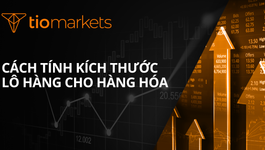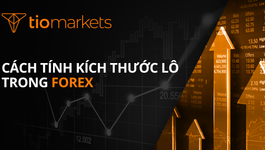What Is Margin Level In Forex Trading And Its Importance
BY Chris Andreou
|tháng 4 20, 2022Although it might not be the first question that comes to mind after hearing about Forex trading, but margin certainly is one of the most important aspects of trading in the markets. Margin level is closely related to leverage, or using a smaller amount of money to trade much larger amounts in the market.
As a way of amplifying your potential returns, it all sounds good at first but there is a downside to trading on margin as well.
Would you like to know what is margin level in Forex trading? We will talk more about it all so keep reading to learn more.
Let’s get started.
Trade 300+ instruments on margin with a reputable broker, open your trading account today.
What is margin in Forex trading?
We hear it all the time from traders, “I lost my margin”, so what does that even mean? Trading on leverage and margin is one of the most important concepts to understand in Forex trading.
Margin is essentially a good faith deposit that the trader puts up to open trades on the brokers trading platform. It acts as a form of collateral against the trade and you are required to maintain an equity minimum for it.
For example, if a trader has $1,000 in their account and they are using 100:1 leverage, they would be able to trade a lot size up to $100,000 worth of currency. The margin required to open the trade would be 100 times less than the deal size.
This is how to calculate margin
lot size in $ / leverage = margin.
Here is an example
$100,000 / 100 = $1,000 margin
If the price starts moving adversely against the direction of your trade, the unrealized loss will start creating negative equity in your account. Which will affect your margin levels.
What is margin level in Forex trading
Margin level is the amount of funds in a trading account that is used to maintain open positions versus the available free balance. Often expressed as a percentage or ratio based on the amount of accessible usable margin versus used margin. In other words, it is the ratio of equity to margin, and is calculated in the following way:
How to calculate Forex margin level
Margin level = (equity / used margin) x 100%
Where equity is equal to the balance, plus or minus the unrealized profit or loss of all current open positions. Unrealized profit or loss becomes realized when trades are closed so the amount is either credited to, or debited from the balance.
What is margin level percentage
For example, if your account balance is $10,000 and your used margin is $5,000, then your margin level will be 200%.
If the unrealized loss of the open positions declines by $1,000, the used margin will stay the same but the equity will become $9,000. Which will affect the margin level percentage.
How to calculate margin level percentage
In this scenario, and using the formula above, the margin level will become;
($9,000 / $5,000) x 100% = 180%
Which is a 20% decrease in margin level
When you have a margin level percentage of 100%, you will get a margin call. This acts as a warning that your positions are at risk of being closed. If you ignore the warning, you run the risk of heading towards a margin stop-out. If the margin level percent reaches 30% of the used margin, the platform will automatically start closing the losing trades to prevent the total loss of your account.
More on margin calls and margin stop-outs in just a moment.
What is free margin when trading?
As you may have already gathered, it is very important to know what your margin level is when trading. You are encouraged to carefully monitor and manage this to avoid the risk of margin calls or margin stop-outs.
A key aspect of this is understanding the concept of free margin along with the margin level. Where your margin level is the ratio or percentage of equity to margin used. Free margin is the amount of money left that is not involved in any trade, you can use it to open more positions.
How to calculate free margin
The free margin is the difference between the equity and used margin.
Free margin = equity – used margin
If your open positions are accruing unrealized profits, you will have more equity, so you will have more free margin available as a result. If your positions are accruing unrealized losses, this will decrease the equity and reduce the available free margin.
This is where you need to be cautious of over leveraging your account to reduce the probability of losing your margin. Because the more positions that you open and the more the equity draws down, the faster you will go to a margin call or a margin stop-out.
What are margin calls? How do they work?
When the account equity falls below the maintenance margin requirement, it will trigger a margin call. A margin call is given when the margin level percent reaches 100%. It is a notification that you should deposit additional funds into your trading account to ensure you can cover the open positions.
If your positions continue to move against your prediction, you will suffer greater losses. Possibly more than the funds deposited in your account and to prevent that, there are a couple more fail-safes.
The first one is a margin stop-out, the second one is negative balance protection. The latter is a safety mechanism that prevents your trading account from going in to a negative balance. So you can not lose more than the amount you have deposited in your trading account.
The trading platform will automatically close your losing positions when your margin level reaches 30% of the used margin, before the negative balance protection kicks in.
This is what we refer to as a margin-stop out.
What is a margin stop-out? Why is it important?
A margin stop-out level is a specific point at which a trader’s open positions start to get closed automatically by the trading platform. Due to a decrease in margin levels, they can no longer support the open positions. The platform will start closing the largest losing trades first, in order to free up some used margin.
The percentage that needs to be reached before a margin stop-out takes place varies from one broker to another. A higher margin stop-out level means that you have a smaller buffer in order to top up your account. With a lower margin stop-out level, you have more time to deposit and bring your margin levels back up.
With TIOmarkets, the margin stop-out level is 30% of the used margin. This also provides a small buffer for price gaps or rapid price movements that may otherwise send the account balance negative.
Although TIOmarkets provides negative balance protection for traders, the point is that an account shouldn’t get there.
It is important for traders to distinguish between what a margin call and margin stop-out is and how they work. As not knowing about either can lead to significant financial losses and even more stress than is necessary.
What is a good margin level to maintain?
Common sense tells us that when we have more funds we can trade bigger volumes, and when we have less funds we can trade smaller volumes. leverage allows traders to take bigger positions with just a small amount of money in their accounts. So it is imperative to strike the right balance between the trade size and the number of open trades with the accounts capitalization or equity.
This is why experienced traders always keep an eye on their margin level. If you get a margin call, take it as a warning that you are over leveraging your account. In other words, it’s best not to allow your equity to fall below a margin level of 100%.
In the event that it does, you might want to consider closing out some of your position, topping up your account or risk a margin stop-out. Just keep in mind that if a margin stop-out occurs, your next trade will be with significantly less volume. Unless you top up the account to trade larger lot sizes again anyway.
Are you are interested, to learn how to change the leverage setting on your trading account?
Conclusion
Your Margin levels are one of the most important things that you need to be aware of when it comes to trading. Margin is the amount of money required in your account to open a position. The Margin level is the percentage of accessible usable margin versus used margin. Free margin is what is left, or available to open new positions.
All Forex brokers require a minimum margin level, which will vary between brokers. When your margin level reaches 100%, it means that you can’t take any new positions. Because all the funds available are being used to sustain the existing open positions. At this point, you will also get a margin call.
If you ignore the notification to top up your account to increase your margin levels, you run the risk of a margin stop-out. Which will happen when the margin level percent reaches 30% of the used margin.
Trade 300+ instruments on margin with a reputable broker, open your trading account today.
Risk disclaimer: CFDs are complex instruments and come with a high risk of losing money rapidly due to leverage. You should consider whether you understand how CFDs work and whether you can afford to take the high risk of losing your money. Never deposit more than you are prepared to lose. Professional client’s losses can exceed their deposit. Please see our risk warning policy and seek independent professional advice if you do not fully understand. This information is not directed or intended for distribution to or use by residents of certain countries/jurisdictions including, but not limited to, USA & OFAC. The Company holds the right to alter the aforementioned list of countries at its own discretion.
Join us on social media

Experienced independent trader





